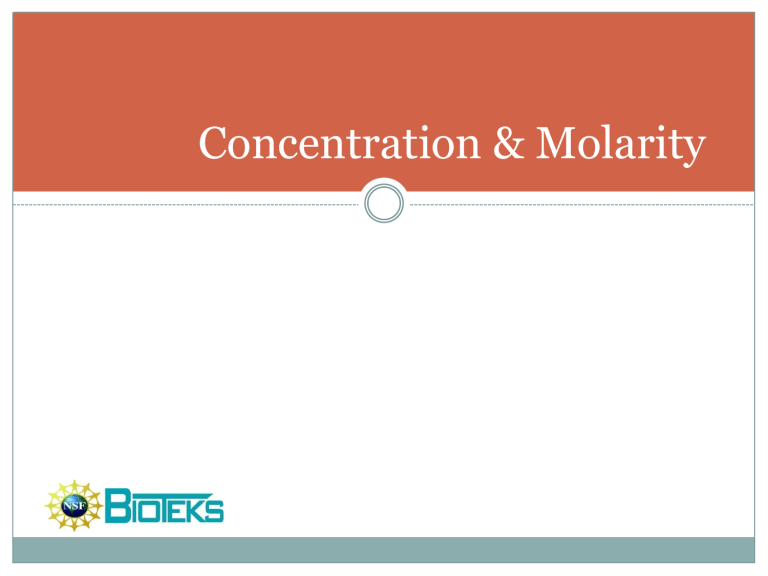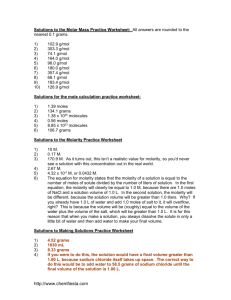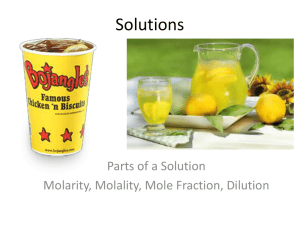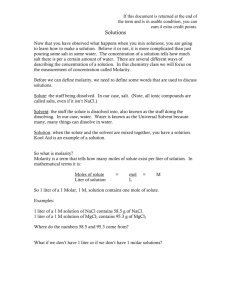Molarity - MATCOnline

Concentration & Molarity
Concentration & Molarity
Concentration can be expressed as a fraction
(weight/volume and volume/volume)as well as a percent (w/v % and v/v %).
Concentration may also be expressed in terms of
molarity.
Molarity
Molarity is a concentration expression that is equal to the number of moles of a solute (n) that are dissolved per liter of solution (L)
Moles of solute
Molarity (M) =
Liters of solution or mol
L
When the number of molecules in a solution is important, molarity is used.
The Importance of Molarity
For example, in an enzyme-catalyzed reaction, the numbers of molecules of each reactant and the enzyme are important.
The more enzyme added to the experiment increases the reaction rate. If there is too little enzyme relative to the number of molecules of reactants present, the reaction may be incomplete, while adding too much enzyme is costly and inefficient.
Determining Molarity
A mole of any element always contains 6.02 X 10 23
(Avogadro’s number) atoms.
A mole of one element weighs a different amount than another element since some atoms are heavier than others.
The weight of a mole of a given element is defined to be equal to its atomic weight in grams, or its gram
atomic weight.
Determining Molarity
The weight of a mole of a given element is defined to be equal to its atomic weight in grams, or its gram
atomic weight.
The atomic weight of an element can be found on a periodic table of elements. (i.e. one mole of the element carbon weighs 12.0 grams)
Determining Molarity
Compounds are composed of atoms of two or more elements that are bonded together.
A mole of a compound contains 6.02 X 10 23 molecules of that compound.
The weight in grams of 1 mole of the compound is the gram formula weight or gram molecular
weight (MW) of a compound.
Determining Molarity
The MW of a compound is calculated by adding the atomic weights of the atoms that make up the compound.
For example, the molecular weight of sodium sulfate
(Na
2
SO
4
) is 142.04 g per mole:
2 sodium atoms 2 x
22.99g = 45.98 g
1 sulfur atom 1 x
32.06g = 32.06 g
4 oxygen atoms 4 x
16.00g = 64.00 g
= 142.04 g
Calculating Molarity
MOLARITY
M = n /
V
= mol /
L
Calculate the molarity of a solution prepared by mixing 1.5 g of
NaCl in 500.0 mL of water.
First calculate the moles of solute:
1.5 g NaCl ( 1 mole NaCl ) = 0.0257 moles of NaCl
58.45 g NaCl
Next convert mL to L: 0.500 L of solution
Last, plug the appropriate values into the correct variables in the equation:
M = mol / L = 0.0257 moles / 0.500 L = 0.051 mol/L
MOLARITY
M = n /
V
= mol /
L
How many grams of LiOH is needed to prepare 250.0 mL of a 1.25 M solution?
First calculate the moles of solute needed:
M = n /
V
, now rearrange to solve for n: n = (1.25 mol /
L
) (0.2500 L)
= 0.3125 moles of solute needed n = MV
Next calculate the molar mass of LiOH: 23.95 g/mol
Last, use diminsional analysis to solve for mass:
0.3125 moles (23.95 g LiOH / 1 mol LiOH) = 7.48 g of LiOH
MOLARITY
M = n /
V
= mol /
L
What is the molarity of hydroiodic acid if the solution is 47.0% HI by mass and has a density of 1.50 g/mL?
First calculate the mass of solute in the 47.0% solution using the density. The 1.50 g/mL is the density of the solution but only 47.0% of the solution is the solute therefore:
47.0% of 1.50 g/mL = (0.470) (1.50 g/mL) = 0.705 g/mL density of solute
Since molarity is given in moles per liter and not grams we must convert the g/mL to mol/mL using the molar mass.
0.705 g/mL (1 mole/ 128 g) = 0.00551 mol/mL
Next convert mL to L:
0.00551 mol/mL (1000 mL/ 1L) = 5.51 mol/L = 5.51 M
MOLARITY & DILUTION
M
1
V
1
= M
2
V
2
The act of diluting a solution is to simply add more water (the solvent) thus leaving the amount of solute unchanged.
Since the amount or moles of solute before dilution ( n b moles of solute after the dilution ( n a n b
= n a
) are the same:
) and the
And the moles for any solution can be calculated by n=MV
A relationship can be established such that
M b
V b
= n b
= n a
= M a
V a
Or simply : M b
V b
= M a
V a
MOLARITY
& Dilution
Calculate the molarity of a solution prepared by diluting 25.0 mL of 0.05
M potassium iodide with 50.0 mL of water (the densities are similar).
M
1
= 0.05 mol/L
V
1
= 25.0 mL
M
1
V
1
= M
2
V
2
M
V
2
2
= ?
= 50.0 + 25.0 = 75.0 mL
M
1
V
1
= M
2
= (0.05 mol/L) (25.0 mL) = 0.0167 M of KI
V
2
75.0 mL
MOLARITY
& dilution
Given a 6.00 M HCl solution, how would you prepare 250.0 mL of 0.150 M HCl?
M
1
= 6.00 mol/L
V
1
= ? mL
M
1
V
1
= M
2
V
2
M
2
= 0.150
V
2
= 250.0 mL
M
2
V
2
= V
1
= (0.150 mol/L) (250.0 mL) = 6.25 mL of 6 M HCl
M
1
6.00 mol/L
You would need 6.25 mL of the 6.00 M HCl reagent which would be added to about 100 mL of DI water in a 250.0 mL graduated cylinder then more water would be added to the mixture until the bottom of the menicus is at 250.0 mL. Mix well.







